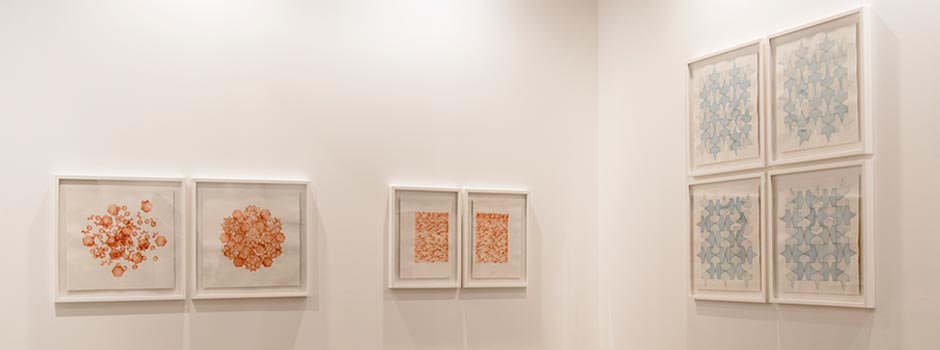
SABRINA AMRANI AT ART DUBAI 2017 Nicène Kossentini - Fugitive at Art Dubai
Mar 19, 2017 Art Event
'Fugitive' marks a return of the artist to drawing and aquarelle. The pieces we had a chance to see at Art Dubai borrow from Islamic geometry and architectural patterns’ aesthetics. The artist is taking her inspiration from the time she spent in Córdoba’s while on a residency in Casa Ãrabe, AndalucÃa. The work is not so much based on exploring Islamic design legacy, rather Kossentini uses ornamental structures to show how life and tradition is getting broken through movement and loss, therefore her ornaments are 'broken' as well. She pursues her existential quest by questioning the contradictions and fluidity of life.
The diptych 'Tawq al-Hamamah' (The Ring of the Dove) is a copy of an excerpt from the eponymous treatise of love written around 1022 by great thinker Ibn Hazm of Córdoba. Just like manuscripts, Kossentini maintains on her soaked papers, a large margin on all sides. She uses her brick-red ink and as the gesture slides and gets blurred, one can sense the fluidity of life and feel that everything, even form changes with time and lines become unstoppable. Is seems that the letters are gently scattered as if a wind pushed everything out of its original context. The writing as well as communication gets lost. The two new drawings investigate the limits of writing as well as the complexity of communication, like 'Shakl', 'Rasail' or, more recently, 'Infinitésimal'. In 'The Poem' Kossentini touches upon the refugees’ fate by exploring the migratory experience from the perspective of homeland loss.
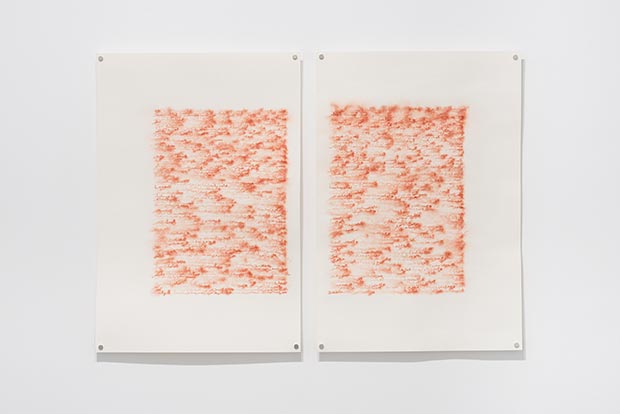 Nicène Kossentini, Tawq al-Hamamah (The ring of the dove) Pages 1&2, 2016. Ink on paper. 51x76 cm / Courtesy of the artist and Sabrina Amrani
Nicène Kossentini, Tawq al-Hamamah (The ring of the dove) Pages 1&2, 2016. Ink on paper. 51x76 cm / Courtesy of the artist and Sabrina Amrani
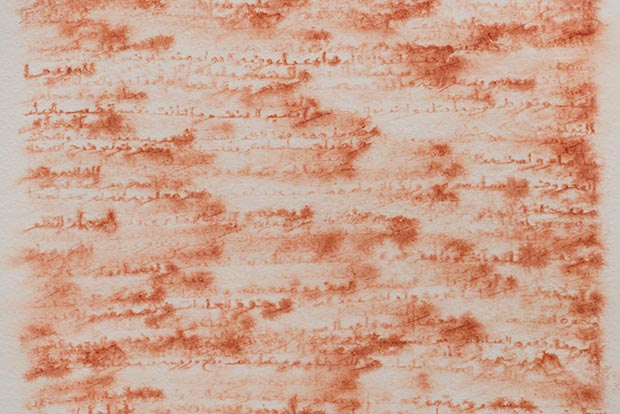 Nicène Kossentini, Detail of Tawq al-Hamamah (The ring of the dove) Pages 1&2, 2016. Ink on paper. 51x76 cm / Courtesy of the artist and Sabrina Amrani
Nicène Kossentini, Detail of Tawq al-Hamamah (The ring of the dove) Pages 1&2, 2016. Ink on paper. 51x76 cm / Courtesy of the artist and Sabrina Amrani
The drawing series 'The Errant' also deals with loss and movement. Kossentini borrows from Islamic geometry to explore cohesion and separation, through patterns that are combined like the body cells. Her organic aquarelles are based on complex squares, circles, stars, and polygons, from delicate blue-grey shades, to green and brick-red, like the colours of the arches of Córdoba’s Great Mosque. The initial outlines are preserved which gives her drawings an organic flow and become a feature. The patterns, unlike mathematically perferct Al-Andalus arabesques, are created and then undone, broken, symbolizing life as a journey with its infinite possibilities of change. Kossentini plays with order and disorder as embodied in 'The Errant / Moment 3'. Her drawings revolve around ambiguity; they suggest zones of encounter and friction, like magnets attracting and repelling each other ('The Errant / Moment 1').
.jpg) Nicène Kossentini, The Errant (Moment 1), 2016. Watercolor and graphite on paper. 100x74 cm. / Courtesy of the artist and Sabrina Amrani
Nicène Kossentini, The Errant (Moment 1), 2016. Watercolor and graphite on paper. 100x74 cm. / Courtesy of the artist and Sabrina Amrani
-detail.jpg) Nicène Kossentini, Detail of The Errant (Moment 1), 2016. Watercolor and graphite on paper. 100x74 cm. / Courtesy of the artist and Sabrina Amrani
Nicène Kossentini, Detail of The Errant (Moment 1), 2016. Watercolor and graphite on paper. 100x74 cm. / Courtesy of the artist and Sabrina Amrani
.jpg) Nicène Kossentini, The Errant (Moment 2), 2016. Watercolor and graphite on paper. 108x108 cm / Courtesy of the artist and Sabrina Amrani
Nicène Kossentini, The Errant (Moment 2), 2016. Watercolor and graphite on paper. 108x108 cm / Courtesy of the artist and Sabrina Amrani
-detail.jpg) Nicène Kossentini, Detail of The Errant (Moment 2), 2016. Watercolor and graphite on paper. 108x108 cm / Courtesy of the artist and Sabrina Amrani
Nicène Kossentini, Detail of The Errant (Moment 2), 2016. Watercolor and graphite on paper. 108x108 cm / Courtesy of the artist and Sabrina Amrani
.jpg) Nicène Kossentini, The Errant (Moment 3), 2016. Watercolor and graphite on paper. 54x108 cm / Courtesy of the artist and Sabrina Amrani
Nicène Kossentini, The Errant (Moment 3), 2016. Watercolor and graphite on paper. 54x108 cm / Courtesy of the artist and Sabrina Amrani
-detail.jpg) Nicène Kossentini, Detail of The Errant (Moment 3), 2016. Watercolor and graphite on paper. 54x108 cm / Courtesy of the artist and Sabrina Amrani
Nicène Kossentini, Detail of The Errant (Moment 3), 2016. Watercolor and graphite on paper. 54x108 cm / Courtesy of the artist and Sabrina Amrani
.jpg) Nicène Kossentini, The Errant (Moment 4), 2016. Watercolor and graphite on paper. 50 cm. diameter each (triptych) / Courtesy of the artist and Sabrina Amrani
Nicène Kossentini, The Errant (Moment 4), 2016. Watercolor and graphite on paper. 50 cm. diameter each (triptych) / Courtesy of the artist and Sabrina Amrani
-detail.jpg) Nicène Kossentini, Detail of The Errant (Moment 4), 2016. Watercolor and graphite on paper. 50 cm. diameter each (triptych) / Courtesy of the artist and Sabrina Amrani
Nicène Kossentini, Detail of The Errant (Moment 4), 2016. Watercolor and graphite on paper. 50 cm. diameter each (triptych) / Courtesy of the artist and Sabrina Amrani
.jpg) Nicène Kossentini, The errant (Moment 5), 2016. Watercolor and graphite on paper. 30 cm. diameter each (triptych) / Courtesy of the artist and Sabrina Amrani
Nicène Kossentini, The errant (Moment 5), 2016. Watercolor and graphite on paper. 30 cm. diameter each (triptych) / Courtesy of the artist and Sabrina Amrani
-detail.jpg) Nicène Kossentini, Detail of The errant (Moment 5), 2016. Watercolor and graphite on paper. 30 cm. diameter each (triptych) / Courtesy of the artist and Sabrina Amrani
Nicène Kossentini, Detail of The errant (Moment 5), 2016. Watercolor and graphite on paper. 30 cm. diameter each (triptych) / Courtesy of the artist and Sabrina Amrani
.jpg) Nicène Kossentini, The errant (Moment 6), 2016. Watercolor and graphite on paper. 50x150 cm / Courtesy of the artist and Sabrina Amrani
Nicène Kossentini, The errant (Moment 6), 2016. Watercolor and graphite on paper. 50x150 cm / Courtesy of the artist and Sabrina Amrani
-detail.jpg) Nicène Kossentini, Detail of The errant (Moment 6), 2016. Watercolor and graphite on paper. 50x150 cm / Courtesy of the artist and Sabrina Amrani
Nicène Kossentini, Detail of The errant (Moment 6), 2016. Watercolor and graphite on paper. 50x150 cm / Courtesy of the artist and Sabrina Amrani
Fugitive has a strong connection with her other series, even if it is not so obvious on the first sight. She uses repetition so often that it takes a real effort to read between the lines. The hidden fragments underneath the drawings might well be the most fundamental components of her works. Kossentini triggers our capacity to dive behind the surface, especially as most of her pieces are set in a unique space-time continuum. She is trying to capture what is fleeing, changing or disappearing.
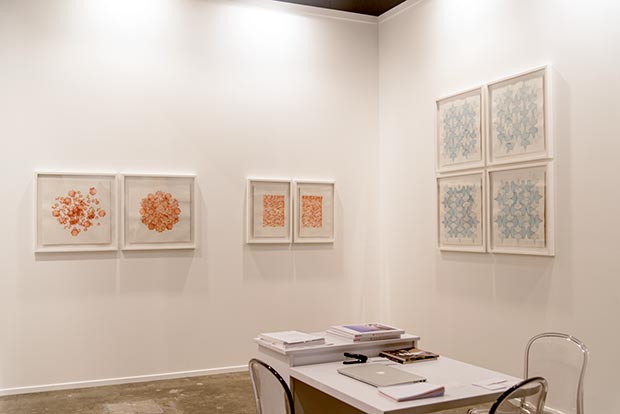 Sabrina Amrani booth at Art Dubai 2017 / Photo © Islamic Arts Magazine
Sabrina Amrani booth at Art Dubai 2017 / Photo © Islamic Arts Magazine
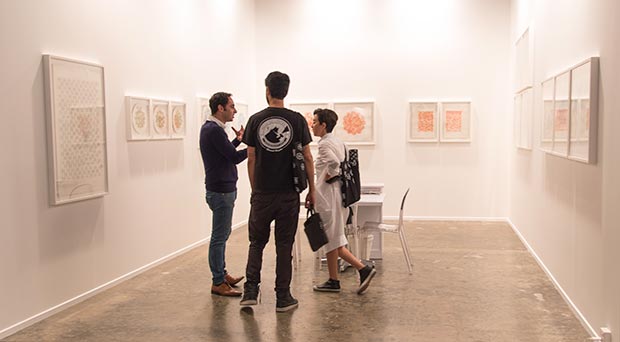 Sabrina Amrani booth at Art Dubai 2017 / Photo © Islamic Arts Magazine
Sabrina Amrani booth at Art Dubai 2017 / Photo © Islamic Arts Magazine
Nicène Kossentini (1976) recently had a retrospective solo exhibition at Muratcentoventidue, Bari (Italy) and currently participates in the group show Effervescence at the Institut des Cultures d'Islam in Paris (France) and in the exhibition Lucy's Iris, curated by Orlando Britto-Jinorio at the MUSAC in León (Spain); which will tour in July to the Musée Departemental de Rochechouart (France) and to the Centro Atlántico de Arte Moderno CAAM in Las Palmas (Spain) in January 2017. Nicène's work has been recently acquired by The British Museum.
Comments
Add a comment